Few animals are more disliked or misunderstood than snakes. Irrational fears and feelings that people have about snakes come from misunderstandings and superstitions handed down from one generation to another. Snakes are not mysterious at all, and their colorful, fascinating life histories do not justify the anxiety many people feel about them.
Most of the 50 species and subspecies of snakes found in Missouri are harmless. (A subspecies is a geographic race of a species.) The five species of venomous snakes found in the state include the Osage copperhead, western cottonmouth (water moccasin), western pygmy rattlesnake, massasauga rattlesnake and timber rattlesnake. Although you should respect venomous snakes and approach them with caution, most snakes you may encounter in an urban environment are harmless and beneficial because they eat insects, mice and other rodents.
This publication seeks to dispel misinformation about snakes and to help Missourians control potential snake problems around homes.
Snake biology and habits
Snakes are reptiles — a group that also includes lizards, alligators and turtles. Reptiles have been around for millions of years.
Snakes are ectotherms, which means they regulate their body temperature by taking heat from their environment or by giving off heat. Because their body temperature is affected by environmental temperatures and varies with surrounding conditions, snakes are inactive during hot seasons (aestivation) and cold seasons (hibernation). Snakes may go for several weeks without eating because of frequent periods of inactivity.
Because snakes are coldblooded, they must rely on behavior to regulate their body temperature. During the hot part of the day, snakes move to shaded areas. On cool days, they sun themselves on rocks or in warm and open areas. Snakes often seek out paved roads because they are attracted by the heat from the road surface.
Because snakes have a backbone, they are classified as vertebrates, the same group as fish, mammals, birds and humans. The snake's skeletal system is unique. Snake bones are light and highly movable. The lower jaws and skull are connected by a piece of stretchy material called a ligament. This ligament allows the snake to open its mouth wide and move each jaw independently. Thus, a snake can swallow prey much larger than its head.
Snakes do not have legs, ears or eyelids. Often the sex organs of a snake protrude from the anal plate area, and some people mistake these for legs.
Snakes use their forked tongues to smell. Their tongue constantly flicks to pick up airborne particles and odors. Once it detects these aromas, the snake inserts its tongue into two holes on the top of its mouth (Jacobson's organ), where its brain interprets the smells. If the snake detects food and is hungry, it will pursue the animal.
Contrary to popular belief, snakes are not slimy. In fact, they feel dry to the touch. The snake's scales and skin help keep it from losing moisture from its body. Snakes shed their skin and eye covering together.
With the warmth of spring, snakes emerge from their winter quarters and search for food and mates. After mating, the male and female snakes separate. Each goes its own way to forage for food until the fall.
Some snakes lay eggs in a damp, protected area where they will hatch in about two months. Other snakes hatch eggs inside the body. Copperheads, rattlesnakes, cottonmouths, garter snakes and water snakes give birth to live young. Once the young have been hatched or born, they are able to take care of themselves. If you find snake eggs around your home or garden, they were laid by a harmless snake.
All snakes are predators, and many are particular about what they eat. Rat snakes eat rats, mice, voles and bird eggs. Water snakes feed primarily on dead, diseased or injured fish. King snakes feed on other snakes, mice, young birds and bird eggs. Some small snakes, such as the rough green snake, eat insects; others, such as earth snakes and worm snakes, eat earthworms, slugs and salamanders. Toads are the favorite food of the hognose snake.
When people encounter a snake, they often corner it. When cornered, a snake will hiss loudly, open its mouth in a threatening manner, coil up and strike at the individual or bluff by advancing toward the person. These behaviors are designed to scare off an intruder. They lead, however, to a common misconception that snakes charge or attack people. In most cases, a snake reacts only if it feels threatened. Usually, it crawls away if it can reach cover safely. One exception is the male black racer, which may chase larger animals, including humans, when it is defending its breeding territory.
Habitat
Snakes prefer to live in areas that provide cover and protection and where food sources are abundant. Likely places to find snakes around homes include
- Firewood stacked directly on the ground;
- Old lumber or junk piles;
- Gardens and flower beds with heavy mulch;
- Untrimmed shrubs and shrubs growing next to a foundation;
- Unmowed and unkempt lawns, abandoned lots and fields with tall vegetation;
- Pond and stream banks with abundant debris and trash;
- Cluttered basements and attics with a rodent, bird or bat problem; and
- Feed storage areas in barn haylofts where rodents abound.
Identification of venomous snakes
All of Missouri's venomous snakes are members of the pit viper family, and you easily can distinguish them from harmless snakes. Venomous snakes in Missouri can be distinguished in three ways:
Pupil shape
The pupil is the black part in the center of the eye. Harmless snakes have round pupils. Venomous snakes have egg-shaped or catlike (elliptical) pupils (Figure 6). In good light, you easily can see the pupil shape from a safe distance because snakes cannot jump, nor can they strike, from more than one-third of their body length.
Pit
Venomous snakes in Missouri also have a conspicuous sensory area or pit, hence the name "pit viper," on each side of the head. The pit looks somewhat like a nostril and helps the snake locate warm-bodied food. It is located about midway between and slightly below the eye and nostril (Figure 6). Harmless snakes do not have pits.
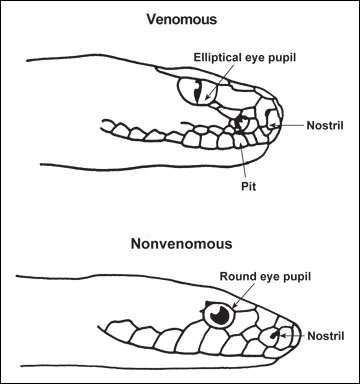 Figure 6
Figure 6
Identifying a venomous snake by its pupils.
Scale arrangement
The underside scales of a venomous snake's tail go all the way across in a single row from the anal plate (Figure 7). The tip of the tail may have two scale rows. Nonvenomous snakes have two rows of scales from the vent to the end of the tail. This characteristic also can be seen on skins that may have been shed.
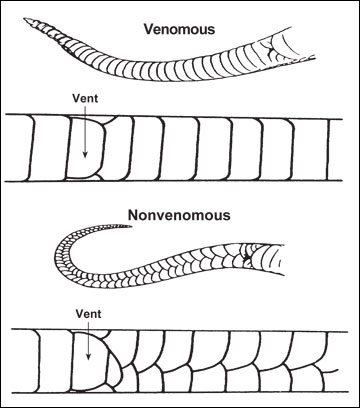 Figure 7
Figure 7
Identifying a venomous snake by its tail.
Features that may help you identify a venomous snake at a distance
Head shape
Usually, venomous snakes have a triangular, or "spade-shaped," head that is wide at the back and attached to a narrow neck. Be aware that many other harmless snakes flatten their heads when threatened and may appear to be venomous.
Distinctive sound
Rattlesnakes usually sound a warning rattle — a buzz or a dry, whirring sound — when approached. However, many nonvenomous snakes (black racers, corn snakes, rat snakes, milk snakes and pine snakes) and several venomous snakes (copperhead and cottonmouth) often vibrate their tails when threatened. The sound produced by this vibration often imitates a rattle or hissing sound when the snake is sitting in dry grass or leaves.
Color patterns and markings
Snakes with lengthwise-striped markings are nonvenomous (Figure 8). Most solid-colored snakes also are nonvenomous, except the adult western cottonmouth, which has dark crossbands that often are indistinct. If a snake is marked in any other way, use other characteristics for identification.
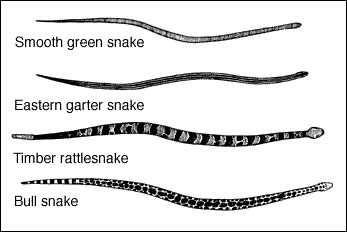 Figure 8
Figure 8
You can learn to distinguish venomous snakes from nonvenomous species by their color and pattern.
Tail
You easily can recognize young cottonmouths and copperheads by their bright yellow or greenish-yellow tails.
Snakebites
Snakebites occur despite precautions. Most first aid texts do not encourage victims of snakebites to kill the snake. The victim may wind up being bitten a second time. Whether the snake is venomous or harmless can be determined within a few minutes if the victim begins to experience pain and swelling at the bite. Also, all snakebites normally are treated with crotalid antivenom, applicable to all venomous species in the state, so identifying the snake is not as important as it once may have been.
You should ask your doctor during a regular visit for advice regarding snakebites. However, if you are bitten:
- Stay calm, and
- Get medical help quickly.
Beneficial aspects of snakes
Before deciding to kill a snake in your yard or garden, consider the many benefits of snakes. Snakes are one of nature's most efficient mouse traps; they kill and eat a variety of rodent pests. Although snakes will not eliminate pests, they do help keep their numbers in check. Some harmless snakes — such as king snakes, milk snakes and black racers — eat other snakes, including venomous ones.
Snake venom has been used to develop a variety of human medicines. One type of high blood pressure medicine was developed using information based on chemical secrets contained in snake venom. Researchers are conducting studies using snake venom in developing treatments for blood and heart problems. Snake venom also is being investigated for controlling some types of harmful bacteria.
Snakes in Missouri are protected by state law. The Wildlife Code of Missouri treats snakes, lizards and most turtles as nongame. Being nongame means there is no open season on these animals, and it is technically illegal to kill them. Of course, realistic exceptions exist, such as when a venomous snake comes in close contact with humans, which could result in someone getting bitten. You should get a collecting permit from the Missouri Department of Conservation before attempting to catch and keep a snake.
Controlling snake problems
The most effective and lasting method for discouraging snakes is to modify the environment so they find it unattractive.
Habitat modification
Modify the environment by removing the snake's shelter and its food source.
Lawns and fields kept clean and closely mowed are less attractive to snakes than are areas of tall grass, weeds, brush and junk. Remove other hiding places, such as old boards lying on the ground and piles of rock and trash. Trim shrubs and bushes so limbs are at least 12 inches from the ground.
Stack fireplace or stove wood away from your home on a rack at least 12 inches off the ground.
Cleaning around the yard also removes rodent habitat, eliminating a favorite food source for snakes. Also, reduce a snake's food source by placing garbage in sealed trash cans, not bags, away from the house. If you feed pets outside, keep all dog food and cat food cleaned up after each feeding, and store feed in a steel trash can, making it unavailable to rodents.
Chemical control
No fumigants or toxicants are federally registered for snake control. The potential for development of such snake controls is complicated by the diet, body temperature and other biological aspects of snakes.
A granular formulation containing the active ingredients naphthalene and sulfur has been registered by the Environmental Protection Agency (EPA) as a snake repellent. Note, however, that repellents can fail due to a variety of factors, including weather conditions or an inability to repel certain species of snakes. Be sure to read and follow all label directions when using repellents.
Exclusion
Snakes enter buildings in search of cool, damp, dark areas or places where rodents and insects abound. To prevent these unwanted guests from entering your home, check the foundation for cracks and openings a quarter inch or larger.
To seal holes or cracks, use mortar for poured concrete, concrete block or brick foundations. Use ¹/8-inch mesh hardware cloth or sheet metal for wooden buildings. Use caulk to seal cracks and openings around windows, doors, electrical pipes and wiring.
If you have an open septic tank or sump-pump drain outside, cover the opening with 1/4-inch mesh hardware cloth. Check it periodically to ensure that the wire does not interfere with drainage.
If you have young children and live in an area where venomous snakes are common, you may want to invest in a snakeproof fence (Figure 9). Semipermanent snakeproof fences are expensive to construct, so fencing an entire yard is not practical. However, you can enclose a small area where young children play.
To construct a semipermanent snakeproof fence, use 1/4-inch mesh hardware cloth at least 36 inches wide. Set the lower 4 inches of the fence into the ground. The fence should slant outward at a 30-degree angle. Place supporting stakes inside the fence (Figure 9 detail). You can make the fence sturdier by attaching wires from the fence to the stakes. If you use a gate, it must fit tightly and should open to the inside because of the outward slope of the fence.
A more temporary, less expensive design uses a fine-mesh net, the bottom 2 to 3 inches of which are set into the ground, with metal or wooden support stakes slanted outward at a 30-degree angle for support.
Keep grass and weeds around the fence mowed close to the ground to prevent snakes from using them to crawl over the fence.
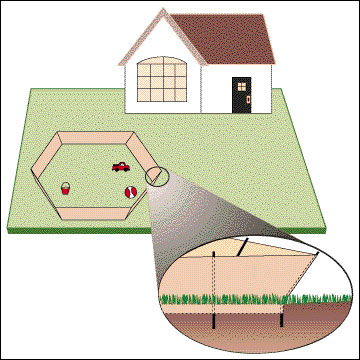 Figure 9
Figure 9
A snake-proof fence can keep snakes from entering an area, such as the child's play area shown above.
Removal from inside buildings
Occasionally, homeowners find a snake inside the home, usually in a basement or crawl space. Snakes are attracted to these areas by the warmth on cold days and the shade on hot days. They may enter through a hole around the foundation or an open or loose door or basement window. If snakes do enter, you need to get them out and then seal the holes.
You increase your chances of capturing a snake in the house by placing, in areas where snakes have been seen, some rumpled, damp cloths covered by dry cloths. Snakes are attracted to such areas. You then can remove the whole works, snake and cloths, or capture the snake individually. A good way to remove a snake is to sweep it with a broom into a large bucket.
Another effective way to capture snakes is to use a glueboard. You can buy these in a variety of places, such as hardware or agriculture supply stores. Most small snakes can be captured using a single glueboard placed against a wall. Keep the board away from pipes or other objects a snake could use for leverage to escape.
Covered glueboards are also available. These traps are bascially rectangular boxes that are open on each end and have glue on the bottom inside surface. Place a closed side of this trap against a wall so the snake will get trapped in it as it crawls along the wall.
A more elaborate arrangement is necessary to capture larger snakes (Figure 10). This type of glue trap can be made at home with purchased glueboards. It is constructed of 1/4-inch plywood cut into 16-by-24-inch sections. Drill a 3/4-inch hole in one corner to allow removal of the board by using a hook on the end of a long stick. Fasten two to four glueboards (or use bulk glue) along one side of the plywood board. This type of trap, when placed against a wall, is capable of capturing snakes up to 5 to 6 feet long.
Use glueboards only indoors or under structures where children, pets or other wildlife cannot reach them. The glue is quite messy and hard to remove. Use common cooking oil or vegetable oil to remove animals from the glue. Be sure to seal any holes or entrances so the snakes do not return.
Once you have trapped a snake on a glueboard, take it to a shaded location in a remote area. To release the snake unharmed from the board, pour vegetable oil over the snake and glue.
Remember, snakes are an important part of our natural world. Although relocating bothersome snakes is sometimes necessary, the best approach in managing a snake problem is, where possible, to leave the animal alone.
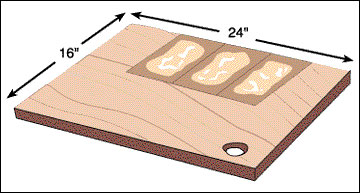 Figure 10
Figure 10
Large glueboard to catch snakes.
Prevention and control tips
Outdoors
- Remove snakes' food and shelter. Keep your lawn closely mowed, and remove debris.
- Control rodents. (See MU Extension publications G9442, Controlling House Mice, and G9446, Controlling Rats.)
- Watch where you put your hands and feet when removing or cleaning debris. If possible, don't put fingers under debris you intend to move.
- Wear snakeproof boots at least 10 inches high or snake leggings if you're in an area where snakes are likely to be found. Never step over logs or other obstacles unless you can see the other side.
- If you encounter a snake, step back and allow it to go on its way. Snakes usually don't move fast, and you can retreat from the snake's path.
Indoors
- Check foundation for holes and cracks, and seal all openings.
- If you find a snake in your home, try to isolate it within a small area.
- You can catch a nonvenomous snake by pinning it down with a long stick or pole, preferably forked at one end, and then removing it by scooping it up with a flat-blade shovel.
- If you can't remove the snake yourself, find someone with experience handling snakes to do it for you. Your local animal-control shelter is a good place to start.
- As a last resort, you may need to kill a venomous snake. Club it with a long stick, rod or tool such as a garden hoe. Never try to kill a venomous snake with an instrument that brings you within the snake's striking range, which is usually no more than one-third the length of the snake.
Other sources of information
Missouri Department of Conservation
- Information on snake identification is available in their "Missouri Snakes" publication, https://mdc.mo.gov/sites/default/files/mo_nature/downloads/page/MissouriSnakes.pdf.
- The Amphibians and Reptiles of Missouri, by Tom R. Johnson, is an excellent reference on Missouri's snakes, turtles, lizards and frogs, available for purchase from http://www.mdcnatureshop.com.
Field guides from other sources:
- A Field Guide to Reptiles and Amphibians: Eastern and Central North America, by Roger Conant and Joseph T. Collins, is in the Peterson's Field Guide series published by Houghton Mifflin Co., Boston.
- National Audubon Society Field Guide to North American Reptiles and Amphibians is published by Alfred A. Knopf, New York.